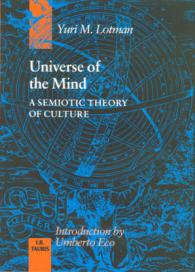- ホーム
- > 洋書
- > 英文書
- > History / World
Full Description
This study analyses the social and symbolic value of the material culture, in particular the pottery production and the architecture, and the social structure of the local communities of a broad area encompassing Eastern Anatolia, the South Caucasus and North-western Iran during the last phase of the Late Bronze Age and the Early Iron Age. This broad area is known from the Assyrian texts as 'Nairi lands'. The second part of the study, furnishes a reassessment of pottery production characteristics and theories, as well as of the socio-economic structure and issues, tied to the sedentary and mobile local communities of the Nairi lands.
The study brings into focus the characteristics, the extension and the distribution of Grooved pottery, along with other pottery typologies, by providing an accompanying online catalogue with detailed descriptions and high-resolution images of the pots and sherds obtained from public and private institutions in Turkey and Armenia. Moreover, the socio-political organisation and subsistence economy issues are addressed in order to advance a possible reconstruction of the social structure of the Nairi lands communities. Particular attention is devoted to the pastoral nomad component and the role played within the Nairi phenomenon. The study includes a very large corpus of text images and high-resolution color images of the pottery of the area under examination, gathered by the author in order to offer a reliable tool and compendium.
Contents
List of figures
List of tables
Acknowledgements
Abstract
Part I. Introduction
1. Research introduction
1.1 The Nairi lands. Questions and issues
1.2 Objectives of the study
1.3 Approaches, methodologies and resources
1.4 Structure of the study
Part II. Theoretical Framework
2. Identity, ethnicity and culture
2.1 Identity
2.2 Ethnicity
2.3 Culture
2.4 Significance and use in the study
3. The concept of community
3.1 Approaches and aspects
Part III. Geographical and Historical Framework
4. An environmental survey of the Nairi lands
4.1 Core: Eastern Anatolia (Turkey)
4.2 Periphery: South Caucasus
4.3 Outer Periphery: North-western Iran
5. The Late Bronze-Early Iron Age historical framework
5.1 Collapse and regeneration of the Near Eastern socio-economic landscape
6. The Anatolian geopolitical landscape according to the Assyrian texts
6.1 The Late Bronze Age
6.2 The Early Iron Age
Summary
Part IV. The Nairi Lands Core: The Archaeological Evidence from Eastern Anatolia
7. Archaeological evidence
7.1 North EAR
7.2 South-east EAR
7.3 South-west EAR
7.4 East SEAR
7.5 West SEAR
Summary
Part V. The Nairi Lands Periphery: The Archaeological Evidence from the South Caucasus
8. Archaeological evidence
8.1 Archaeological investigations in Armenia and the South Caucasus
8.2 Armenia
8.3 Nakichevan and Azerbaijan
8.4 Georgia
Summary
Part VI. The Nairi Lands Outer Periphery: The Archaeological Evidence from North-Western Iran and Secondary Connections
9. Archaeological evidence
9.1 Archaeological investigations and issues in North-western Iran
9.2 North-western Iran
9.3 Secondary connections outside the Nairi lands
Summary
Part VII. Reassessment of the Nairi Lands Material Culture and Socio-Economic Landscape
10. Nairi Ware: The Nairi lands pottery productions
10.1 Issues and theories
10.2 Techno-morphological analysis
10.3 Reassessment
11. The Nairi lands socio-economic landscape: Between mobile and sedentary lifestyle
11.1 Merging ethnicities and social groups
11.2 The Settlement Area
11.3 The Encampment Area
11.4 The Fort Area
11.5 Convergent dimorphism
Part VIII. Final Considerations
12. The Nairi lands communities' identity
12.1 Commonalities and distinguishing features
12.2 Identity as cultural affinity and community
12.3 The Nairi Ware social and symbolic function
12.4 Conclusions and future directions
Appendix: Pottery sherds analyses
Guido Guarducci, Vincenzo Palleschi, Marco Lezzerini, Stefano Pagnotta, Gianni Gallello, Emanuela Grifoni, Stefano Legnaioli, Giulia Lorenzetti and Giusi Sorrentino
Bibliography
Online catalogue
Nairi Lands contexts and architecture
Anatolia
South Caucasus
Iran
Secondary connections
Nairi Ware pottery
Anatolia
South Caucasus
Iran
Secondary connections



![初めてでもできる!超初心者のパソコン入門 [テキスト]](../images/goods/ar2/web/imgdata2/48663/4866365900.jpg)



